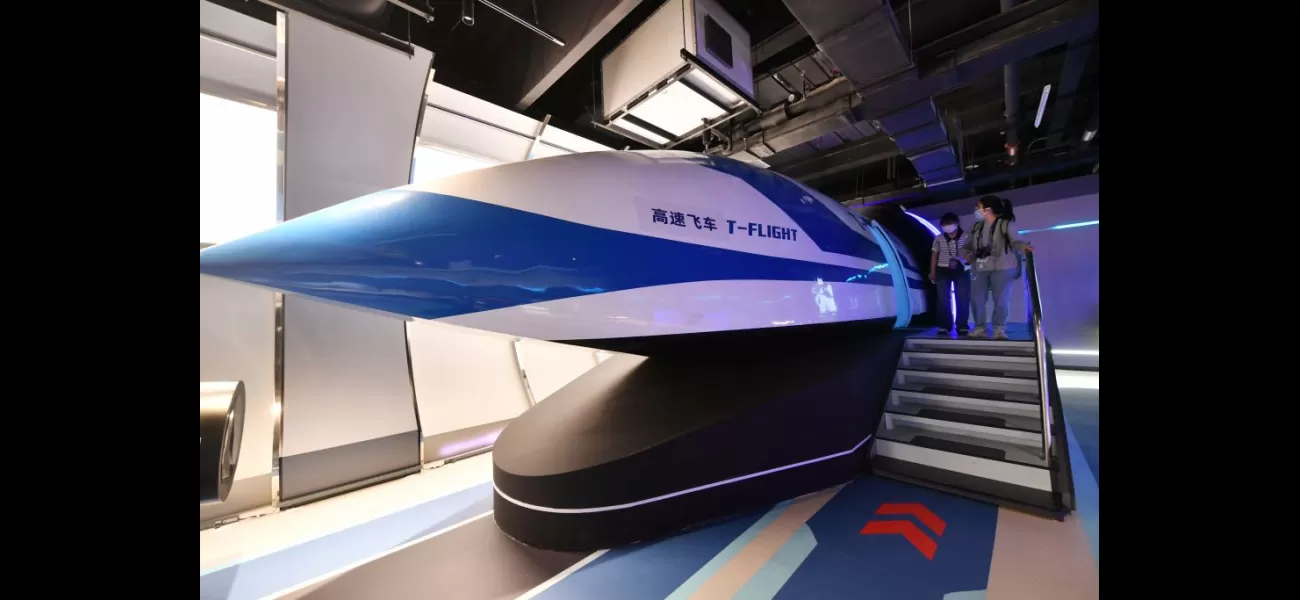China unveils new magnetic train that can exceed the speed of sound.
Discuss the power of magnetism.
March 1st 2024.

China has recently unveiled its latest engineering achievement - the T-flight supersonic train. This technological wonder has left many in awe, with some even speculating that it might make airplanes obsolete.
According to Chinese engineers, the T-flight train has reached an impressive speed of 387mph on a test track, breaking the world speed record. To put this into perspective, the current record holder, Japan's MLX01 Maglev, travels at a top speed of 361mph.
But that's not all. Once the T-flight train is fully operational, it is expected to reach an astonishing speed of 1,243mph - faster than the speed of sound and more than twice the speed of a Boeing 737 plane. How is this possible, you may ask? The answer lies in the train's use of magnetic levitation technology, which eliminates the need for traditional wheels and instead uses magnets to lift the pods above the track, allowing them to glide effortlessly.
This concept was first proposed by US engineer Robert Goddard in 1910 but gained renewed interest after billionaire Elon Musk published a white paper on the subject in 2013. Now, the T-flight train has been built by the China Aerospace Science and Industry Corporation, with hopes of using it as a hyperloop train for efficient transportation.
If all goes as planned, the T-flight train could potentially cover the distance from Wuhan to Beijing in just over 30 minutes, a significant improvement from the current four-hour journey on a high-speed train. The initial testing took place on a 1.2-mile track within a low-pressure vacuum tube, with a tolerance of only 0.01 inches to ensure minimal friction and maximum speed.
As the project progresses, the agency aims to extend the track to 60km, allowing the train to potentially reach a speed of 621mph. However, the project's chief designer, Mao Kai, acknowledges that it is a challenging and complex system, with some aspects still uncharted territory in China.
Recently, the train underwent its first successful test, and reports from the South China Morning Post indicate that the vehicle and track interacted smoothly, and the maglev vehicles remained stable. The safety controls also performed as expected, paving the way for the future of high-speed transportation in China.
With the T-flight train's potential to revolutionize travel, we may soon be able to hop on a high-speed train and cross the country in a matter of hours. The future of transportation is indeed exciting, and the T-flight train is just one step towards a cleaner, faster world.
According to Chinese engineers, the T-flight train has reached an impressive speed of 387mph on a test track, breaking the world speed record. To put this into perspective, the current record holder, Japan's MLX01 Maglev, travels at a top speed of 361mph.
But that's not all. Once the T-flight train is fully operational, it is expected to reach an astonishing speed of 1,243mph - faster than the speed of sound and more than twice the speed of a Boeing 737 plane. How is this possible, you may ask? The answer lies in the train's use of magnetic levitation technology, which eliminates the need for traditional wheels and instead uses magnets to lift the pods above the track, allowing them to glide effortlessly.
This concept was first proposed by US engineer Robert Goddard in 1910 but gained renewed interest after billionaire Elon Musk published a white paper on the subject in 2013. Now, the T-flight train has been built by the China Aerospace Science and Industry Corporation, with hopes of using it as a hyperloop train for efficient transportation.
If all goes as planned, the T-flight train could potentially cover the distance from Wuhan to Beijing in just over 30 minutes, a significant improvement from the current four-hour journey on a high-speed train. The initial testing took place on a 1.2-mile track within a low-pressure vacuum tube, with a tolerance of only 0.01 inches to ensure minimal friction and maximum speed.
As the project progresses, the agency aims to extend the track to 60km, allowing the train to potentially reach a speed of 621mph. However, the project's chief designer, Mao Kai, acknowledges that it is a challenging and complex system, with some aspects still uncharted territory in China.
Recently, the train underwent its first successful test, and reports from the South China Morning Post indicate that the vehicle and track interacted smoothly, and the maglev vehicles remained stable. The safety controls also performed as expected, paving the way for the future of high-speed transportation in China.
With the T-flight train's potential to revolutionize travel, we may soon be able to hop on a high-speed train and cross the country in a matter of hours. The future of transportation is indeed exciting, and the T-flight train is just one step towards a cleaner, faster world.
[This article has been trending online recently and has been generated with AI. Your feed is customized.]
[Generative AI is experimental.]
0
0
Submit Comment





